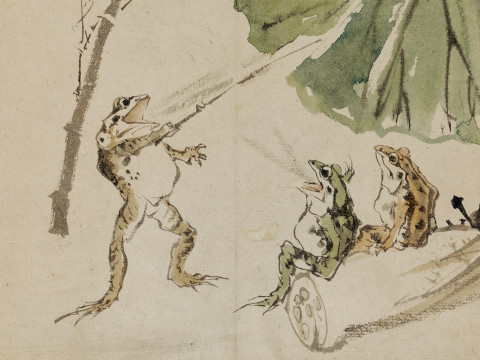
From aquatints to woodcuts: a visual glossary of original prints
By Amy Macpherson
Published on 24 April 2014
We take a look at the main printmaking techniques and some of the terminology you'll encounter when looking at original prints.
If you're visiting the London Original Print Fair this weekend, you'll see a vast array of prints executed in a number of different techniques.
Brush up on your print terminology with our gallery below, in which we've illustrated some commonly used printmaking terms using examples from the Royal Academy Collection.
Main printmaking techniques:
Relief print The image is cut out of the block. The proud areas are inked and the image is transferred onto paper by press or hand.
Intaglio A plate is incised with an image, which is transferred to paper by a mangle-style press.
Lithography The image is produced on stone or zinc plates. Based on the principle that grease repels water, areas of the plate are made receptive to ink, while others remain blank in the printed image.
Screenprint The image is built up in layers by pushing ink through a mesh using a squeegee. This method is derived from commercial printing processes.
Digital print The image is created using computer software and is then printed using archival inks on high-quality paper.

A method that applies tonal areas to an etching, traditionally by adding rosin or asphalt to the plate before biting it in acid.
In this example, by Norman Ackroyd RA ('St Kilda - Stac Lee and Stac an Armin', 1990) which is an etching and aquatint, the technique helps suggest sheets of rain and wind enveloping two sea stacks off the north-west coast of Scotland.

A digital or photographic print on high-quality paper. This example by Liane Lang ('Ars Moriendi', 2006) was produced during her final year as a student at the Royal Academy Schools, and features one of the RA Collection's sculpture casts.

The image is scratched directly onto an etching plate, acetate or cardboard, creating a burr that results in a rich and fluffy line. The plate is then bitten in acid and printed. This example by Henry Rushbury RA ('The Walls of Gerona', 1936) was the artist's Diploma Work - an art work given to the RA Collection when the artist first becomes a Royal Academician.

Colour, usually watercolour, which is applied to the image after printing. This example, by Isaac Robert Cruikshank and George Cruikshank, is from the 1821 publication 'Life in London' and shows visitors to the Royal Academy.

A method whereby areas of a piece of linoleum are cut away before printing the remaining surface as a relief print. In this example, 'Pelicans' by Haydn Reynolds Mackey, the individual marks made by the cutting tool are used to suggest feathers and blades of grass.

A unique print produced by making additions to a basic image, or by printing it in different colours. This example ('Spice Island', 1986) is by Allen Jones RA.

A photomechanical process using a light-sensitive gelatin tissue that is exposed to a film positive and then etched. This results in a print with the detail and continuous tones of a photograph. This example by Sir Lawrence Alma-Tadema RA ('Caracalla: AD 211', 1836) features the neoclassical imagery for which the Victorian artist was well known.

An etching produced by drawing onto a piece of paper that is in contact with a prepared etching plate. The pressure of the pencil on the paper removes the resist, and the plate is then bitten with acid before the image is printed. This example, by Norman Stevens ARA ('Hidden Gate', 1976) is on display at the RA until 25 May 2014 as part of the exhibition 'Norman Stevens ARA: Selected Prints'.

The image is cut or gouged into a plank of wood which has been cut along the grain. The light areas are removed and the image is surface-rolled and printed using the relief process. This image of the The Four Horsemen of the Apocalypse dates from 1511 and is by the legendary painter and printmaker Albrecht Dürer.
Related articles

The meteoric rise of Angelica Kauffman RA
2 January 2024

Untold Stories
26 October 2023

RA Collections Decolonial Research Project
28 March 2022

Late Constable Tour with Curator Anne Lyles
6 December 2021

